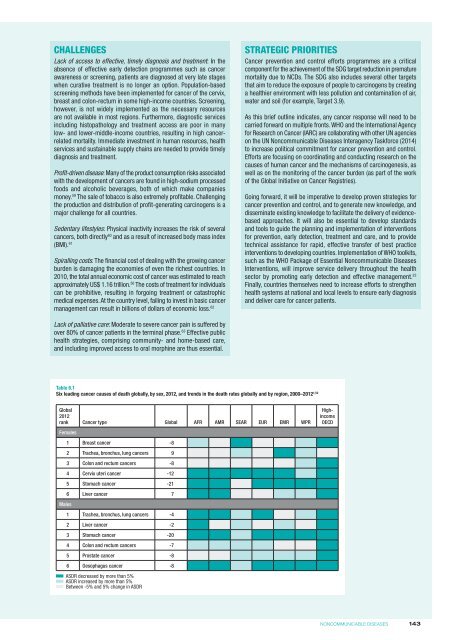Create successful ePaper yourself
Turn your PDF publications into a flip-book with our unique Google optimized e-Paper software.
CHALLENGES<br />
Lack of access <strong>to</strong> effective, timely diagnosis and treatment: In the<br />
absence of effective early detection programmes such as cancer<br />
awareness or screening, patients are diagnosed at very late stages<br />
when curative treatment is no longer an option. Population-based<br />
screening methods have been implemented for cancer of the cervix,<br />
breast and colon-rectum in some high-income countries. Screening,<br />
however, is not widely implemented as the necessary resources<br />
are not available in most regions. Furthermore, diagnostic services<br />
including his<strong>to</strong>pathology and treatment access are poor in many<br />
low- and lower-middle-income countries, resulting in high cancerrelated<br />
mortality. Immediate investment in human resources, health<br />
services and sustainable supply chains are needed <strong>to</strong> provide timely<br />
diagnosis and treatment.<br />
Profit-driven disease: Many of the product consumption risks associated<br />
with the development of cancers are found in high-sodium processed<br />
foods and alcoholic beverages, both of which make companies<br />
money. 59 The sale of <strong>to</strong>bacco is also extremely profitable. Challenging<br />
the production and distribution of profit-generating carcinogens is a<br />
major challenge for all countries.<br />
Sedentary lifestyles: Physical inactivity increases the risk of several<br />
cancers, both directly 60 and as a result of increased body mass index<br />
(BMI). 61<br />
Spiralling costs: The financial cost of dealing with the growing cancer<br />
burden is damaging the economies of even the richest countries. In<br />
2010, the <strong>to</strong>tal annual economic cost of cancer was estimated <strong>to</strong> reach<br />
approximately US$ 1.16 trillion. 56 The costs of treatment for individuals<br />
can be prohibitive, resulting in forgoing treatment or catastrophic<br />
medical expenses. At the country level, failing <strong>to</strong> invest in basic cancer<br />
management can result in billions of dollars of economic loss. 62<br />
STRATEGIC PRIORITIES<br />
Cancer prevention and control efforts programmes are a critical<br />
component for the achievement of the SDG target reduction in premature<br />
mortality due <strong>to</strong> NCDs. The SDG also includes several other targets<br />
that aim <strong>to</strong> reduce the exposure of people <strong>to</strong> carcinogens by creating<br />
a healthier environment with less pollution and contamination of air,<br />
water and soil (for example, Target 3.9).<br />
As this brief outline indicates, any cancer response will need <strong>to</strong> be<br />
carried forward on multiple fronts. WHO and the International Agency<br />
for Research on Cancer (IARC) are collaborating with other UN agencies<br />
on the UN Noncommunicable Diseases Interagency Taskforce (2014)<br />
<strong>to</strong> increase political commitment for cancer prevention and control.<br />
Efforts are focusing on coordinating and conducting research on the<br />
causes of human cancer and the mechanisms of carcinogenesis, as<br />
well as on the moni<strong>to</strong>ring of the cancer burden (as part of the work<br />
of the Global Initiative on Cancer Registries).<br />
Going forward, it will be imperative <strong>to</strong> develop proven strategies for<br />
cancer prevention and control, and <strong>to</strong> generate new knowledge, and<br />
disseminate existing knowledge <strong>to</strong> facilitate the delivery of evidencebased<br />
approaches. It will also be essential <strong>to</strong> develop standards<br />
and <strong>to</strong>ols <strong>to</strong> guide the planning and implementation of interventions<br />
for prevention, early detection, treatment and care, and <strong>to</strong> provide<br />
technical assistance for rapid, effective transfer of best practice<br />
interventions <strong>to</strong> developing countries. Implementation of WHO <strong>to</strong>olkits,<br />
such as the WHO Package of Essential Noncommunicable Diseases<br />
Interventions, will improve service delivery throughout the health<br />
sec<strong>to</strong>r by promoting early detection and effective management. 23<br />
Finally, countries themselves need <strong>to</strong> increase efforts <strong>to</strong> strengthen<br />
health systems at national and local levels <strong>to</strong> ensure early diagnosis<br />
and deliver care for cancer patients.<br />
Lack of palliative care: Moderate <strong>to</strong> severe cancer pain is suffered by<br />
over 80% of cancer patients in the terminal phase. 63 Effective public<br />
health strategies, comprising community- and home-based care,<br />
and including improved access <strong>to</strong> oral morphine are thus essential.<br />
Table 6.1<br />
Six leading cancer causes of death globally, by sex, 2012, and trends in the death rates globally and by region, 2000–2012 1,52<br />
Global<br />
2012<br />
rank Cancer type Global AFR AMR SEAR EUR EMR WPR<br />
Females<br />
1 Breast cancer -8<br />
2 Trachea, bronchus, lung cancers 9<br />
3 Colon and rectum cancers -8<br />
4 Cervix uteri cancer -12<br />
5 S<strong>to</strong>mach cancer -21<br />
6 Liver cancer 7<br />
Males<br />
1 Trachea, bronchus, lung cancers -4<br />
2 Liver cancer -2<br />
3 S<strong>to</strong>mach cancer -20<br />
4 Colon and rectum cancers -7<br />
5 Prostate cancer -8<br />
6 Oesophagus cancer -8<br />
ASDR decreased by more than 5%<br />
ASDR increased by more than 5%<br />
Between -5% and 5% change in ASDR<br />
Highincome<br />
OECD<br />
NONCOMMUNICABLE DISEASES<br />
143


